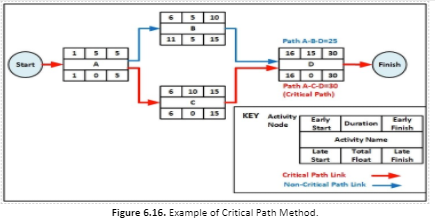
-
*SCHEDULE NETWORK ANALYSIS
Schedule network analysis is the overarching technique used to generate the project schedule model.
It employs several other techniques such as critical path method, resource optimization techniques, and modeling techniques.
-
*CRITICAL PATH METHOD
The critical path method is used to estimate the minimum project duration and determine the amount
of schedule flexibility on the logical network paths within the schedule model.
This schedule network analysis technique calculates the early start, early finish, late start,
and late finish dates for all activities without regard for any resource limitations by performing
a forward and backward pass analysis through the schedule network, as shown in Figure 6-16.
In this example, the longest path includes activities A, C, and D, and therefore the sequence of A-C-D is the critical path.
The critical path is the sequence of activities that represents the longest path through a project,
which determines the shortest possible project duration. The longest path has the least total float—usually zero.
The resulting early and late start and finish dates are not necessarily the project schedule;
rather they indicate the time periods within which the activity could be executed,
using the parameters entered in the schedule model for activity durations, logical relationships, leads, lags, and other known constraints.
The critical path method is used to calculate the critical path(s) and the amount of total
and free float or schedule flexibility on the logical network paths within the schedule model.
-
*RESOURCE OPTIMIZATION
Resource optimization is used to adjust the start and finish dates of activities to adjust planned resource use to be
equal to or less than resource availability. Examples of resource optimization techniques that can be used to adjust
the schedule model due to demand and supply of resources include but are not limited to:
-
Resource leveling.
-
A technique in which start and finish dates are adjusted based on resource constraints
-
with the goal of balancing the demand for resources with the available supply (Figure 6.17).
-
Resource smoothing.
-
A technique that adjusts the activities of a schedule model such that the requirements for resources
-
on the project do not exceed certain predefined resource limits.